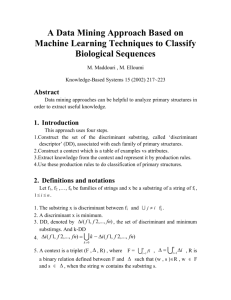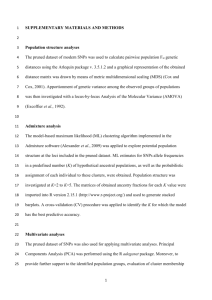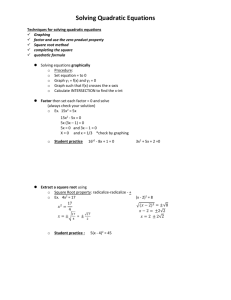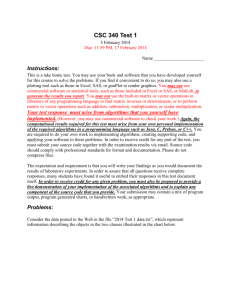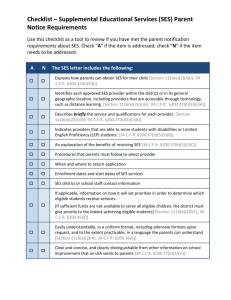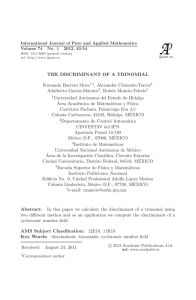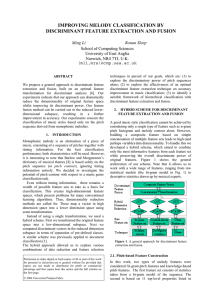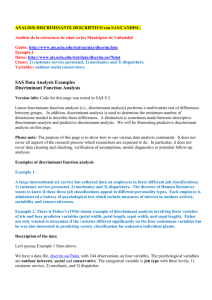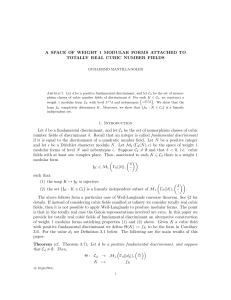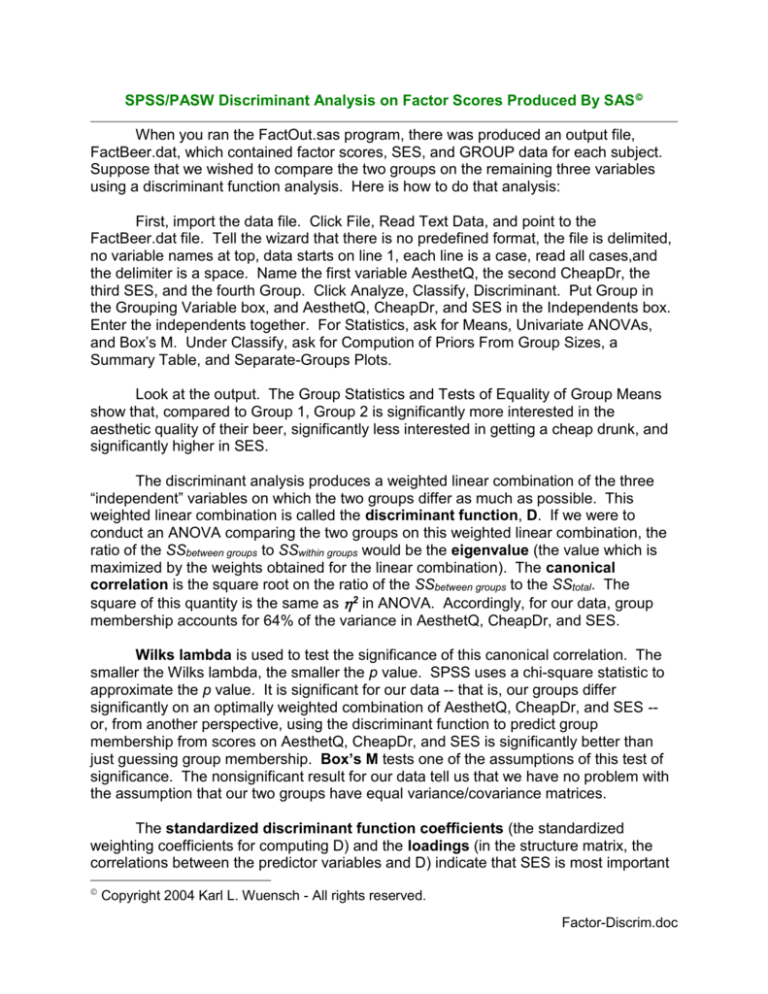
SPSS/PASW Discriminant Analysis on Factor Scores Produced By SAS
When you ran the FactOut.sas program, there was produced an output file,
FactBeer.dat, which contained factor scores, SES, and GROUP data for each subject.
Suppose that we wished to compare the two groups on the remaining three variables
using a discriminant function analysis. Here is how to do that analysis:
First, import the data file. Click File, Read Text Data, and point to the
FactBeer.dat file. Tell the wizard that there is no predefined format, the file is delimited,
no variable names at top, data starts on line 1, each line is a case, read all cases,and
the delimiter is a space. Name the first variable AesthetQ, the second CheapDr, the
third SES, and the fourth Group. Click Analyze, Classify, Discriminant. Put Group in
the Grouping Variable box, and AesthetQ, CheapDr, and SES in the Independents box.
Enter the independents together. For Statistics, ask for Means, Univariate ANOVAs,
and Box’s M. Under Classify, ask for Compution of Priors From Group Sizes, a
Summary Table, and Separate-Groups Plots.
Look at the output. The Group Statistics and Tests of Equality of Group Means
show that, compared to Group 1, Group 2 is significantly more interested in the
aesthetic quality of their beer, significantly less interested in getting a cheap drunk, and
significantly higher in SES.
The discriminant analysis produces a weighted linear combination of the three
“independent” variables on which the two groups differ as much as possible. This
weighted linear combination is called the discriminant function, D. If we were to
conduct an ANOVA comparing the two groups on this weighted linear combination, the
ratio of the SSbetween groups to SSwithin groups would be the eigenvalue (the value which is
maximized by the weights obtained for the linear combination). The canonical
correlation is the square root on the ratio of the SSbetween groups to the SStotal. The
square of this quantity is the same as 2 in ANOVA. Accordingly, for our data, group
membership accounts for 64% of the variance in AesthetQ, CheapDr, and SES.
Wilks lambda is used to test the significance of this canonical correlation. The
smaller the Wilks lambda, the smaller the p value. SPSS uses a chi-square statistic to
approximate the p value. It is significant for our data -- that is, our groups differ
significantly on an optimally weighted combination of AesthetQ, CheapDr, and SES -or, from another perspective, using the discriminant function to predict group
membership from scores on AesthetQ, CheapDr, and SES is significantly better than
just guessing group membership. Box’s M tests one of the assumptions of this test of
significance. The nonsignificant result for our data tell us that we have no problem with
the assumption that our two groups have equal variance/covariance matrices.
The standardized discriminant function coefficients (the standardized
weighting coefficients for computing D) and the loadings (in the structure matrix, the
correlations between the predictor variables and D) indicate that SES is most important
Copyright 2004 Karl L. Wuensch - All rights reserved.
Factor-Discrim.doc
for separating the two groups and AesthetQ least important. The centroids are simply
the mean values on D for each group.
The classification statistics tell us that the prior probabilities are 55% for Group
1 and 45% for Group 2. The classification process takes these priors into account when
predicting which group a subject is in. Ceteris paribus, one should be a little more likely
to predict membership in Group 1 than in Group 2. The graphs and the summary table
show us that the discriminant function was successful in predicting group membership
for 10 out of 11 subjects who were actually members of Group 1 and 7 out of 9 subjects
who were actually members of Group 2, for an overall success rate of 85%. If you did
not have the discriminant function, but you knew that there were members of Group 1
than of Group 2, you best “guessing strategy” would be to guess membership in Group
1 for every subject. In that case your overall success rate would be only 55%.
The url for this document is http://core.ecu.edu/psyc/wuenschk/MV/FA/FactorDiscrim.doc.
Return to Wuensch’s Statistics Lessons Page
Copyright 2009, Karl L. Wuensch - All rights reserved.



